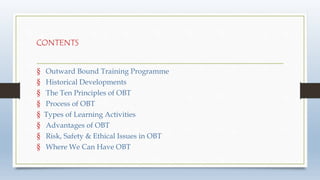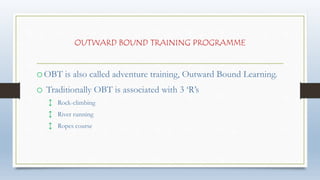Outward bound training programme
- 1. OUTWARD BOUND TRAINING PROGRAMME Radhakrishnan
- 2. CONTENTS ┬¦ Outward Bound Training Programme ┬¦ Historical Developments ┬¦ The Ten Principles of OBT ┬¦ Process of OBT ┬¦ Types of Learning Activities ┬¦ Advantages of OBT ┬¦ Risk, Safety & Ethical Issues in OBT ┬¦ Where We Can Have OBT
- 3. OUTWARD BOUND TRAINING PROGRAMME oOutward Bound Training is also called ŌĆśadventureŌĆÖ training which is uses physical challenge in outdoor & wild settings combined with facilitations. oOBT is conducted in the quite and calm environments away from the workplace.
- 4. OUTWARD BOUND TRAINING PROGRAMME oOBT is also called adventure training, Outward Bound Learning. o Traditionally OBT is associated with 3 ŌĆśRŌĆÖs ŌåĢ Rock-climbing ŌåĢ River running ŌåĢ Ropes course
- 5. OUTWARD BOUND TRAINING PROGRAMME The outbound training programme is very high energy programme for enhancing individual and team performance. Through these outbound training programme skills improvement takes place in areas of teamwork, team bonding, communication, leadership, time management, problem solving, decision making, change management and personality development.
- 6. THE TEN PRINCIPLES OF OBT The ten design principles are short statements of the philosophy of education and core values of Outward Bound & Expeditionary Learning, drawn from the work of OBT founder ŌĆ£Kurt HahnŌĆØ and other educational leaders.
- 7. THE TEN PRINCIPLES OF OBT The Primacy of Self-Discovery The Having of Wonderful Ideas The Responsibility for Learning Empathy and Caring Success and Failure
- 8. THE TEN PRINCIPLES OF OBT Collaboration and Competition Diversity and Inclusion The Natural World Solitude and Reflection Service and Compassion
- 9. HISTORICAL DEVELOPMENTS OF OBT
- 10. HISTORICAL DEVELOPMENTS OF OBT OBT approach is derived from the educational philosophy advocated by Dr. Kurt Hah (1886-1974). He believed in the need for real, action and value-oriented educational experience.
- 11. PROCESS OF OBT
- 13. Framing is pre-activity explanations of the event in which the scenario is painted with description, goals determined, and the rules laid out.
- 14. Implementation is the second step in OBT which comes after framing, during implementation, the participants are put through a series of activities.
- 15. Debriefing Comes at the end of the learning activity, in debriefing facilitator helps the participants to find what they felt, how they inferred meaning in each of the activities.
- 16. TYPES OF LEARNING ACTIVITIES
- 17. Pointillism Colour Mass Initiative Activities Challenge Courses High Element Courses Low Challenge Courses Wilderness and High Adventure of Activities
- 19. Advantages of obt +Holistic +Clear and simple goals +Concrete Experiences +New and Funny Activities +Risk Taking
- 20. RISK, SAFETY & ISSUES IN OBT Considering the safety measures taken in OBT programmes, they can be assumed to be much safer than a social outing. There are ethical issues that are called the ethics of challenge by choice. Accordingly the participants only partake in events when they truly want to and only to the degree they wish. Protective devices like gum boots, helmets and other life-saving equipments are used while performing activities considered as dangerous.
- 21. Myths associated with OBT ŌĆĢ OBT is for the able-bodied ŌĆĢ OBT is in outdoors and male-dominated ŌĆĢ OBT is the ultimate panacea
- 22. Send your feedback to hrkrish@ymail.com
- 23. Thank you ’üŖ























